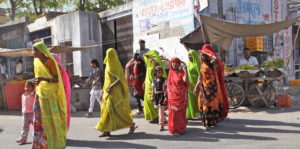 The girls at Sewa womens organisation isn Lucknow taking a break from their hand embroidered chickankari work.
The girls at Sewa womens organisation isn Lucknow taking a break from their hand embroidered chickankari work.

On the streets of Jodphur, such an incredibly beautiful picture….
” Saris belong to a region rather than a social strata. Everyone from the cobblers wife to the goldsmiths wife wears the sari of the region
Saris make women look beautiful and elegant whether at work, shopping, doing house work, building roads or at leisure; she will have a variety of saris in her wardrobe, to suit formal and informal occasions and the change in weather. Older women will tend to wear heavier cloths, as they prefer not to wear slips beneath.
A traditional Indian costume for women, made up of a single 6 yard (5 12/2m, or 11 m for two) long piece of fabric. The sari is wound, pleated and secured over a matching bodice (a vest) and a separate under skirt (a slip) drawn high at the waist, taking care to leave a long length (a pallu) that drapes in folds over one shoulder, which is used much like a scarf or a stole. A sari is woven with a contrasting border along one or both selvedges, which become the hem, and the pallu edge; the extra density of the cloth and the weight helps the sari to hang well and to a degree protects the skirt hem from wear and tear.
The textiles used for saris come in a full array of colours, designs, embroidery techniques, craftsmanship and tradition and women willow several, each for certain occasion.
The sheer muslins, cottons and organdies of worn saris especially translate into recycled curtains, blinds and bed drapes, the bright printed cottons into cushions for the garden and the conservatory, and the simpler, plainer, heavier cloths and the white-on-whites particularly suit open, contemporary settings.
On the Amber Road
Some well known sari fabrics are: zardosi, varanese, jamdani …
Rta Kapur Chishti has made of the study of Sari traditions, weaving, dying and draping her life’s work, a well-recommended read! Saris: Tradition and Beyond. Roli books.

